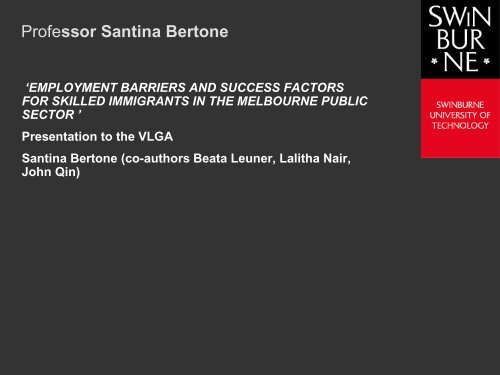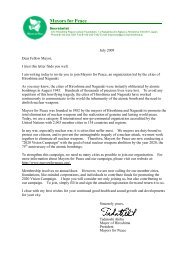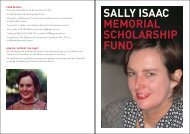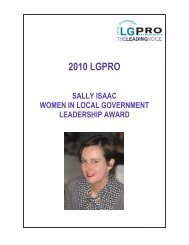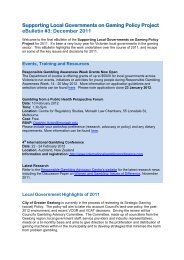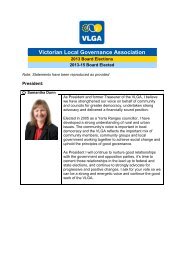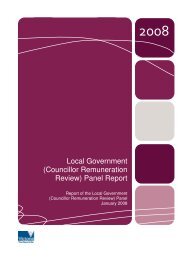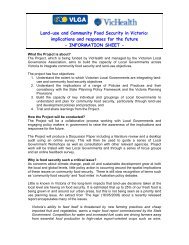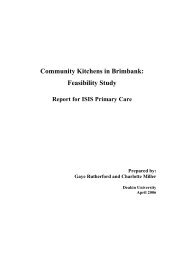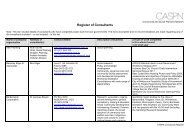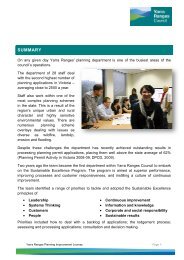Professor Santina Bertone - Victorian Local Governance Association
Professor Santina Bertone - Victorian Local Governance Association
Professor Santina Bertone - Victorian Local Governance Association
- No tags were found...
Create successful ePaper yourself
Turn your PDF publications into a flip-book with our unique Google optimized e-Paper software.
<strong>Professor</strong> <strong>Santina</strong> <strong>Bertone</strong>‘EMPLOYMENT BARRIERS AND SUCCESS FACTORSFOR SKILLED IMMIGRANTS IN THE MELBOURNE PUBLICSECTOR ’Presentation to the VLGA<strong>Santina</strong> <strong>Bertone</strong> (co-authors Beata Leuner, Lalitha Nair,John Qin)
Research Workshop – 7 JulySwinburneMigration Program Outcomes 1997-98 to 2007
Research Workshop – 7 JulySwinburneBackground- Immigrants are highly skilled- Engineers, doctors, nurses, IT professionals, accountants and many more- Three major avenues of entry – permanent (independent, family,humanitarian), temporary (e.g. 457 visa) and on-shore graduates- Main source countries: NZ, UK, India, China, Philippines, Iraq, Sri Lanka,Malaysia, Burma- A quarter of the labour force is from non-English speaking countries- In Victoria, it is 17.55%, and in NSW 19.24%
Research Workshop – 7 JulySwinburneProblems of skill transfer- Flatau, 1995 – NESB migrants three times more likelyto face ‘over-education’ at work- Green et al., 2004 – over-education higher for NESBs (31% cf. 22%) withAsians at 36%- Kler, 2006 – over-educated ESBs 16%, Europeans 39%, Asians 49%- Kler found significant earnings differences too, in favour of ESBs- Unemployment also higher for NESBs (Thapa, 2004)- The gaps are closing but still there (Hawthorne, 2005)- Barooah & Mangan, 2007 – returns to education lower for East Asians andother Asians, however, working in the public sector increased chances ofhigher incomes- Doucouilagos, 2004 – found that NESB migrants in the VPS received lowerreturn on education than ESB and Australian-born, 57% less for a PhD
Research Workshop – 7 JulySwinburneWhy is over-education and poor skill utilisation aproblem?• Wasted human resources, loss of productivity• Emotional and confidence issues for the victims• Lesser opportunities and poorer living standards• Under-performing immigration program• Less culturally and linguistically diverse sectors
Research Workshop – 7 JulyThe Ian Potter study (2010)Sought to explore these questions:Swinburne- Are there factors at the workplace level which may be contributing to theunder-representation of NESB/CALD immigrants in the <strong>Victorian</strong> publicsector?- Are there employment barriers, formal or informal, limiting the entry andparticipation of skilled NESB/CALD immigrants into the <strong>Victorian</strong> publicsector?- Where applicable, how do these barriers (policies, behaviours, practices)manifest in everyday working life?- What kinds of cultural diversity management strategies seem to mitigate theeffect of such barriers, and which make them worse?- What can be done to solve the problem and how do the stakeholders(managers, employees) in the public sector view such strategies and culturaldiversity management in general?- Methodology based on interviews, focus groups and document analysis(2 local government, 2 state government agencies) and analysis of ABSCensus 2006
Research Workshop – 7 JulySwinburneVictoria University Study (2010)- Asked the same questions and used the same approach, minus the focusgroups (i.e interviews only)- in total, 16 metropolitan councils were covered (when Ian Potter councilsincluded)
Research Workshop – 7 JulySwinburneFindingsCensus –In Victoria:- 17.8% of federal public sector jobs held by NESB migrants- 11.4% of state public sector jobs held by NESB migrants- 11.5% of local government jobs held by NESB migrants- Expected level based on general workforce figures – 17.55%- (this is a 52% difference between NESB employment in local governmentand more broadly in the <strong>Victorian</strong> workforce)- The difference is even more pronounced in NSW (more than 100%difference)
Research Workshop – 7 JulySwinburnePercentage of Employees in <strong>Victorian</strong> public sector(three tiers of government) by Country of BirthPercentage of Employees in Public sector by Country of BirthPlace of Residence Australia MES NMES Total Australia MES NMESObserved valuesExpected values% % % % % % %Federal 72.64460047 9.586537 17.76886 100 74.33005 8.124895 17.54505State 79.87336814 8.691763 11.43487 100 74.33005 8.124895 17.54505<strong>Local</strong> 80.22249691 8.265125 11.51238 100 74.33005 8.124895 17.54505VictoriaPublic 77.67809845 8.924014 13.39789 100 74.33005 8.124895 17.54505Australia Public (as a whole) 77.70791301 10.76149 11.5306 100 74.33005 8.124895 17.54505Victoria No. Employed 74.33005285 8.124895 17.54505 100 74.33005 8.124895 17.54505
Research Workshop – 7 JulySwinburneFocus groups and interviews:- Potential employment barriers for NESB migrants included:- English language proficiency levels- Use of key selection criteria as a screening mechanism- Preference for applicants having Australian experience- Preference for recruiting people like themselves- Lack of local contacts, references and support networks- Other specific technical requirements such as knowledge of local planninglaws, literacy, numeracy, driver’s licence, citizenship etc.
Proposed strategiesSwinburne• Make the recruitment process more explicit/ transparent and allow fordifferent approaches• Use a generic curriculum vitae template• Remove names from applications• Reduce number of key selection criteria and explain how to address them• Mentoring and work experience placements for NESB/CALD people• Target cultural diversity in recruitment through a concerted policy drive• Collect workforce data on cultural diversity• Provide scholarships and bursaries to NESB/CALD people to develop theirskills• Provide cultural diversity training, particularly for those involved inrecruitment.
Contact:<strong>Professor</strong> <strong>Santina</strong> <strong>Bertone</strong>Email: sbertone@swin.edu.auPhone: 9214 5312


